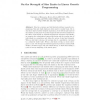Free Online Productivity Tools
i2Speak
i2Symbol
i2OCR
iTex2Img
iWeb2Print
iWeb2Shot
i2Type
iPdf2Split
iPdf2Merge
i2Bopomofo
i2Arabic
i2Style
i2Image
i2PDF
iLatex2Rtf
Sci2ools
GECCO
2004
Springer
2004
Springer
On the Strength of Size Limits in Linear Genetic Programming
Abstract. Bloat is a common and well studied problem in genetic programming. Size and depth limits are often used to combat bloat, but to date there has been little detailed exploration of the effects and biases of such limits. In this paper we present empirical and theoretical analyses of the effect of size limits on variable length linear structures. Specifically, we examine the relationship between size limits and the average size of individuals in a population and define the notion of size limit strength. When a size limit is strong, the average size of a population converges to a relatively stable value. When a size limit is weak, no such convergence occurs. The average size instead appears to perform a random walk within a bounded region. We use schema theory to show this is likely a result of uneven sampling of the search space.
| Added | 01 Jul 2010 |
| Updated | 01 Jul 2010 |
| Type | Conference |
| Year | 2004 |
| Where | GECCO |
| Authors | Nicholas Freitag McPhee, Alex Jarvis, Ellery Fussell Crane |
Comments (0)

